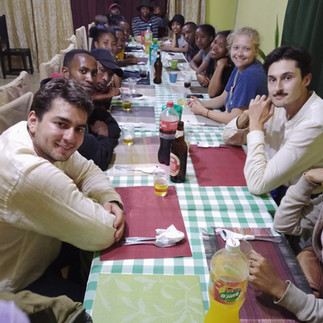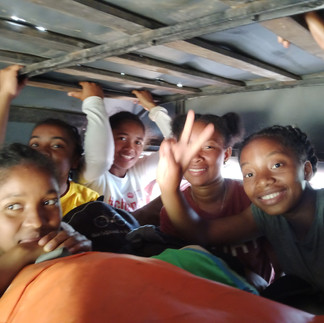Trip of AJPER to Ankarimbelo, through the "jungle" of the rainforest
- Andre Randrianirina

- 14. Nov. 2022
- 7 Min. Lesezeit
Aktualisiert: 15. Nov. 2022
From Friday 21st to Wednesday 25th, October 2022 Participants: 25 malagasy and german group
Reported by Randrianirina André

PURPOSES OF THE TRIP
AJPER is an association of Malagasy students that aims to provide solutions to reduce the use of charcoal and firewood, source of household cooking energy in Madagascar, but also source of deforestation of natural forests in Madagascar. We can’t provide suitable solutions if we don’t know the reality within the community where our activities should be set up. Every member has to understand why the community keeps cutting trees, just experiencing their daily way of lives. This trip to Ankarimbelo is one of the hardest we have made so far, but it is worth it.
The purpose of our trip is then, to teach the manufacturing of basic 2, our new model of firewood stove (saves 50% of wood) to women association FIZAM in Ambohimahamasina, a village in the west side of the rainforest, then to walk through the remaining rainforest “Corridor” to enjoy its beauty and finally to visit Ankarimbelo, one of the villages that where hit by the last cyclone Batsirai.

Map of our trip from Fianarantsoa to Ankarimbelo and to Vohipeno.
Day 1: Friday 21st, October 2022
From: Fianarantsoa – to: Ambohimahamasina, means of transportation: Taxibrousses
The group composed of 20 Malagasy and 5 Germans left Fianarantsoa to join Ambalavao through the RN7 with a taxibrouss. Then once in Ambalavao, we took another taxibrouss that took us to Ambohimahamasina where we stayed an overnight.
We stopped at a river beach to take sands for the basic 2 teaching in the afternoon.
The women association FIZAM received us with enthusiasm, as we are their first “toursits group” after the pandemic. The Germans stayed at a dorm room while the Malagasy group stayed at a separate common room.
After lunch, we started the basic 2 teaching. The teaching was for the members of the association FIZAM, but men also attended.
Mr Romain and Andre open the teaching with a short speech and the presentation of the group to attenders. Then they also responded by welcoming us in their village and also introducing the comity members of their association.Then, Andre explained what a basic 2 stove is and its advantages compared to traditional cook-stove the three stones. The other members showed its components and its usage
We brought 10 prefabricated basic 2 that we gave to the association.
After this, Frederic, Ruphin, Julio led the teaching by showing the needed materials and the molds. Then they made the mixture of the materials: 1 cement, 2 sands, 4 soils.
The cement used for this teaching was brought by AJPER from Fianarantsoa.
After the mixture was ready, they showed the use of each mold. Then, the participants tried making it by themselves.
After the teaching, they showed their interest to continue making the stoves. The only thing they complained is how to deal with the cement because the price of cement is expensive for them.
We ended the teaching with a thank you speech given by the President of the women association.

Orimbato produced by Cementis, the cement of Madagascar is the best for the basic 2 composition.
While waiting for dinner, the team visited Ambohimahamasina, played collective games.
Then we had dinner at a school room. It was hard to deal with vegetarian and non-vegetarian.
Day 2: Saturday 22nd, October 2022
From: Ambohimahamasina – To: Croisement in the middle of the rainforest, by walking for around 25 km

The team had breakfast at 5:00 and started the walk at 6:00. We left Ambohimahamasina with enthusiasm of seeing new landscape but with worries if everyone would make it until the end. We were accompanied by two local guides that brought some of our luggage too.
The walk was long, lots of going up and down in the middle of hills without trees for about 4 hours. Then we started to spot few natural forests. Actually this part of land was covered by natural forest in the past but due to deforestation and cyclic bush fire, only grass grows in this land.
We had lunch at Tsipoapoaka, at a local restaurant.
After lunch, we continued the walk and start to get into the actual rainforest. We crossed many streams and had to take off and put on shoes every minute.
The first day was challenging for the whole team but we made it to the destination. Actually, we planned to sleep at Ankarimbelo which is at 45 km from Ambohimahamasina but we decided to stay an overnight at Croisement, in the middle of the rain forest.
We slept at a small house with two rooms and tent for that night. We also prepared our own dinner and breakfast.
Croisement:
This small village with few houses is located in the middle of the rainforest but is important for local people using the path Ambohimahamasina – Ankarimbelo. Hundreds of people walk between Ambohimahamasina to Ankarimbelo and back every day. Those people are carrying heavy luggage such as pack of tobaccos they sell in the east coast. On their way back, they bring local rhum that they buy from Ankarimbelo region which is delivered in Ambohimahamasina and through the highland. Croisement is then a stop for breakfast, lunch and dinner, the only spot where they can find and buy food. If too late, just like us, people sleep here too.
If Croisement doesn’t exist, local people using the services provided by this place will be in trouble.
However, the Ministry of the Environment and Environmental Organization that protect the rain forest do not accept the existence of Croisement because they are afraid that people will cut trees for agriculture in the future when the needs of the villagers grow.
The owner of the house that hosted us said that they don’t have agriculture but they live only from the revenue they earn from passengers passing by.
AJPER thinks that Croisement should exist and of course regulated by the law to avoid future miss use of land.
It is a beautiful spot with a small river, surrounded by native trees. However, they don’t have toilet or latrine and people just defecate in the bush. This is not good for health and is unfortunate for such a nice place.
Day 3: Sunday 23rd , October 2022
From: Ambohimahamasin: Croisement – To: Ankarimbelo, by walking for around 20 km

We woke up earlier and prepare breakfast before continuing our walk to the east. After Croisement, the path passes through the cliff that separates the highland and the east coast. We climbed down the mountain inside the forest. Some part of the tack was destroyed by the landslide from Batsirai cyclone. We start to see the law land of the east.
That morning, we understand this path is important for local people. We crossed hundreds of people, men women, children that go up carrying chicken, local rhum, bananas and other goods that will be sold in Ambohimahamasina because it was market day there the next Monday.
It is a real human highway.
We spotted birds, snakes and other animals along our way. On half way to Ankarimbelo, there is no forest anymore. Down there, mountains are naked.
We descended from 1200 m to 200 m above the sea. Teams were exhausted but arrived in Ankarimbelo around 3 pm.
Some members of youth association from Ankarimbelo were waiting for us on the foot of the mountain to help us carrying our luggage.
We were again welcomed by the local community with joy and happiness.
The youth association of Ankarimbelo led by Mr Rasolo had an exchange meeting with AJPER members before dinner. We were planned to leave the next morning but they asked us to stay one more day so the group decided to stay.
The German team slept at a tent while Malagasy team slept at a big hall of the commune.
The youth association of Ankarimbelo asked for a sharing with us on how to live in an association, how to lead an association for sustainability and to impact its members and the community.
Day 4: Monday 24th, October 2022
Stay in Ankarimbelo
Day 4 is a relax day. In the morning, we met with local authorities for a courtesy visit.
We also visited the Lycée of Ankarimbelo. The Director said that they had the best result for the last baccalauréat but the students don't know what to do after. We then met with them at their classroom and did an exchange. They don't know which university to enroll in? How is the student life at the University? and so many questions.
The students from AJPER which are current students at the University of Fianarantsoa gave advices and told them how important it is to continue studying at the university after highschool. We explained different faculties and schools existing at the University of Fianarantsoa. The German students also shared with the student of Ankarambelo about their university.

At lunch time, we shared our lunch with kids.
In the afternoon, AJPER team played a football match against the local association. And after dinner, both associations had a camp fire on the open sky.

Hunger in Ankarimbelo region
Ankarimbelo was one of the most hit by the cyclone Batsirai. Rice field and other fields were destroyed by the rain and the wind. Only in this region, 50 people died back that time. Children are so skinny with big belly. People eat roots of plants they found in the field, not edible at all but because of food scarcity, they don’t have any choice but eat what they found to fill up their stomach.
If we do donation next time, we will consider this place.
Day 5: Tuesday 25th, October 2022
Our destination is Fianarantsoa, but we had several steps to arrive in Fianarantsoa. At 6:00 AM, after breakfast, the group left Ankarimbelo, had to cross the river of Matantana by foot, then walk for around 15 km before we could have a car that drove us to Ifanirea. The group was exhausted but we could manage to arrive safely to Ifanirea. Three cars were waiting for us to take us to Vohipeno which is at 60 km from Ifanirea, but the road was paved.
We had lunch at Angado. We also took a ferry with our cars to cross the river of Matitana in Angado.
Then we drove again until Vohipeno. There, an continue to Vohipeno where another taxibrousse was waiting to take us to Manakara, then to Fianarantsoa.
The group arrived in Fianarantsoa at 2:00 AM on Wednesday 26th.
Aknowledgement
I would like to thank all the members at AJPER that made this trip happen for their preparation and their committement to the association. I also would like to thank the 5 germans that came with us and live together this one life time experience.
Special thank you to:
- The two local guides
- Mr Romain Rabearisoa
- Dr Clermont
- Mme Vonjy journalist of the National Television
- Tojo for his translation and his leadership
- Mr Rasolo of Ankarimbelo
- Ny Tanintsika for giving us all the needed contacts
- and the funders that gave us the money for the trip.

The two local guides








































































































































Kommentare